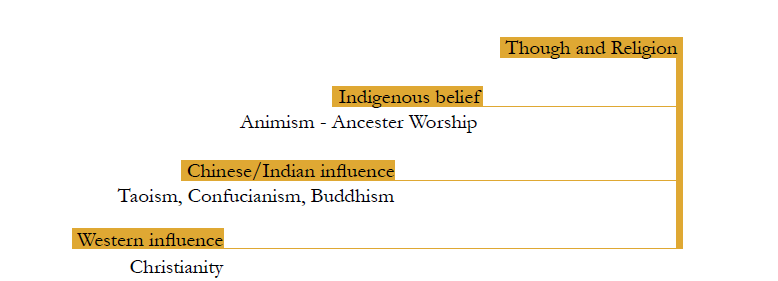[S01.3] Non-religious Spiritual space for social cohesion in Vietnam

Abstract
Chapter 1: Land and People
Chapter 2: Non- religious spiritual space within the framework of social concerns
Chapter 3: Collective- cultural memory and social cohesion
Chapter 4: Case studies
Chapter 5: Design Solution
Chapter 2. Non- religious spiritual space within the framework of social concerns
2.1 Religions and spiritual life in Vietnamese society
In spite of its geographic location in Southeast Asia, there is a common misconception among the Western scholars that Vietnam is originally a part of Sino-sphere, as Duiker stated in his book Vietnam- Revolution in Transition that:
“For nearly ten centuries, the Vietnamese almost seemed to style themselves as a carbon copy of China.” (Duiker 1995)
Traditionally, it was believed that the flow of culture was initially started in the Near East and then spread to India and China before being adopted in Southeast Asia afterwards.
In fact, in the last decades, there are many archaeological excavations indicated that Southeast Asia, not India or China was the cradle of cultivating plants, making pottery and casting bronze- criteria of a primitive culture beginning thousands of years earlier than in the Near East, India or China (Solheim 1971, Tran 1996).
That is to say, the cultural space of Vietnamese culture from the very beginning was constructed in the context of Southeast Asian culture which could be a reasonable explanation for the basic distinctions between Vietnamese and Sinitic culture: if in Sinitic culture, family plays the crucial role in the social structure, clan and community are put in first in Vietnamese culture (Tran 1996). However, during the era of Chinese domination lasted for nearly one thousand years from the last century B.C.E, Chinese influence along with the intrusion of Buddhism, Taoism and Confucianism placed a huge impact on Vietnamese society in all aspects. Despite that, the Viet did not fully assimilate into Chinese culture but retained the spiritual patterns from their indigenous culture and blend them together. On that ground, although Vietnam has a religious diversity with most of the major religions in the world: Buddhism, Christianity, Confucianism, Taoism, Islam, Hinduism, the religious segregation has never been social trouble. In practice, most of the Vietnamese share the same belief (Nguyễn and Kendall 2003) as Leopold Cadière, a French missionary of Paris Foreign Missions Society who spent decades to observe and research about local religions in Vietnam, wrote:
“Vietnam’s true religion is the cult of spirits. This religion has no history because it dates from the origins of the race” (Templer 1999)
“The cult of spirits” mentioned here is an indigenous belief, which is well-known as Animism, that spiritual beings inhabit in nature. Given the fundamental nature of an ancient agricultural society mostly depended on the climate, the Viet showed their respect for natural elements in order to avoid disasters and wish for wealth and peace. Moreover, one of the most crucial expressions of this belief is in the ancestor worship. This spiritual custom is shared among the majority of the Viet of all faiths (figure 1): it is believed that after death, spirits of deceased ancestors still exist in this world to supervise and protect their descendants’ well-being. In other words, the familial bonds (in the sphere of the clan) will go beyond the death and pass on generation to generation.

